#harmful algae bloom
Text

source
#lake erie#harmful algae bloom#algae#algae bloom#lime green#green#water#waves#lake#photography#nature#1k
1K notes
·
View notes
Text
HABs Survey
Can y'all please take my survey on harmful algae blooms? Thanks!
#environment#algae#Florida#habs#phosphorous#organic fertilizer equipment#organic fertilizer production line#environmental#environmentalists#bloom#harmful#harmful algae bloom#natural disasters#online survey#please#take#this#school assignment#beach#water#lagoon#bay#river#lake#sewage#nitrogen#elements#marine science#marine animals#marine life
1 note
·
View note
Text
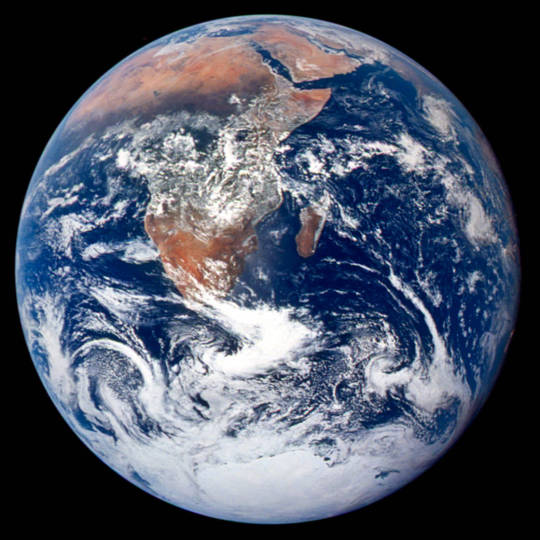
Ways NASA Studies the Ocean
We live on a water planet. The ocean covers a huge part of the Earth's surface – earning it the name Blue Marble.
The ocean is one of Earth’s largest ecosystems and helps moderate Earth’s climate. NASA scientists spend a lot of time studying the ocean and how it is changing as Earth’s climate changes.
In the last few years, NASA has launched an array of missions dedicated to studying this precious part of our planet, with more to come. For World Oceans Month, which starts in June, here are new ways NASA studies the ocean.
youtube
1. Seeing the colors of the ocean 🎨
A new NASA mission called PACE will see Earth’s oceans in more color than ever before. The color of the ocean is determined by the interaction of sunlight with substances or particles present in seawater.
Scheduled to launch in 2024, PACE will help scientists assess ocean health by measuring the distribution of phytoplankton, tiny plants and algae that sustain the marine food web. PACE will also continue measuring key atmospheric variables associated with air quality and Earth's climate.

2. Surveying surface water around the globe 💧
The SWOT satellite, launched in late 2022, is studying Earth’s freshwater – from oceans and coasts to rivers, lakes and more – to create the first global survey of Earth’s surface water.
SWOT is able to measure the elevation of water, observing how major bodies of water are changing and detecting ocean features. The data SWOT collects will help scientists assess water resources, track regional sea level changes, monitor changing coastlines, and observe small ocean currents and eddies.
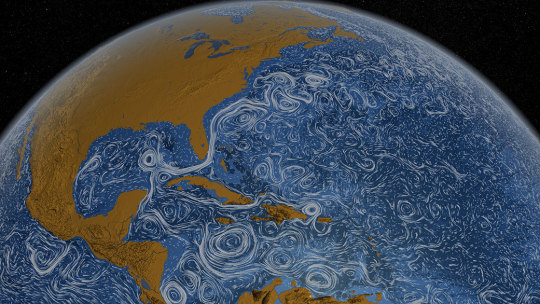
3. Setting sail to understand interactions between the ocean and atmosphere 🚢
With research aircraft, a research ship, and autonomous ocean instruments like gliders, NASA’s S-MODE mission is setting sail to study Earth’s oceans up close. Their goal? To understand ocean whirlpools, eddies and currents.
These swirling ocean features drive the give-and-take of nutrients and energy between the ocean and atmosphere and, ultimately, help shape Earth’s climate.
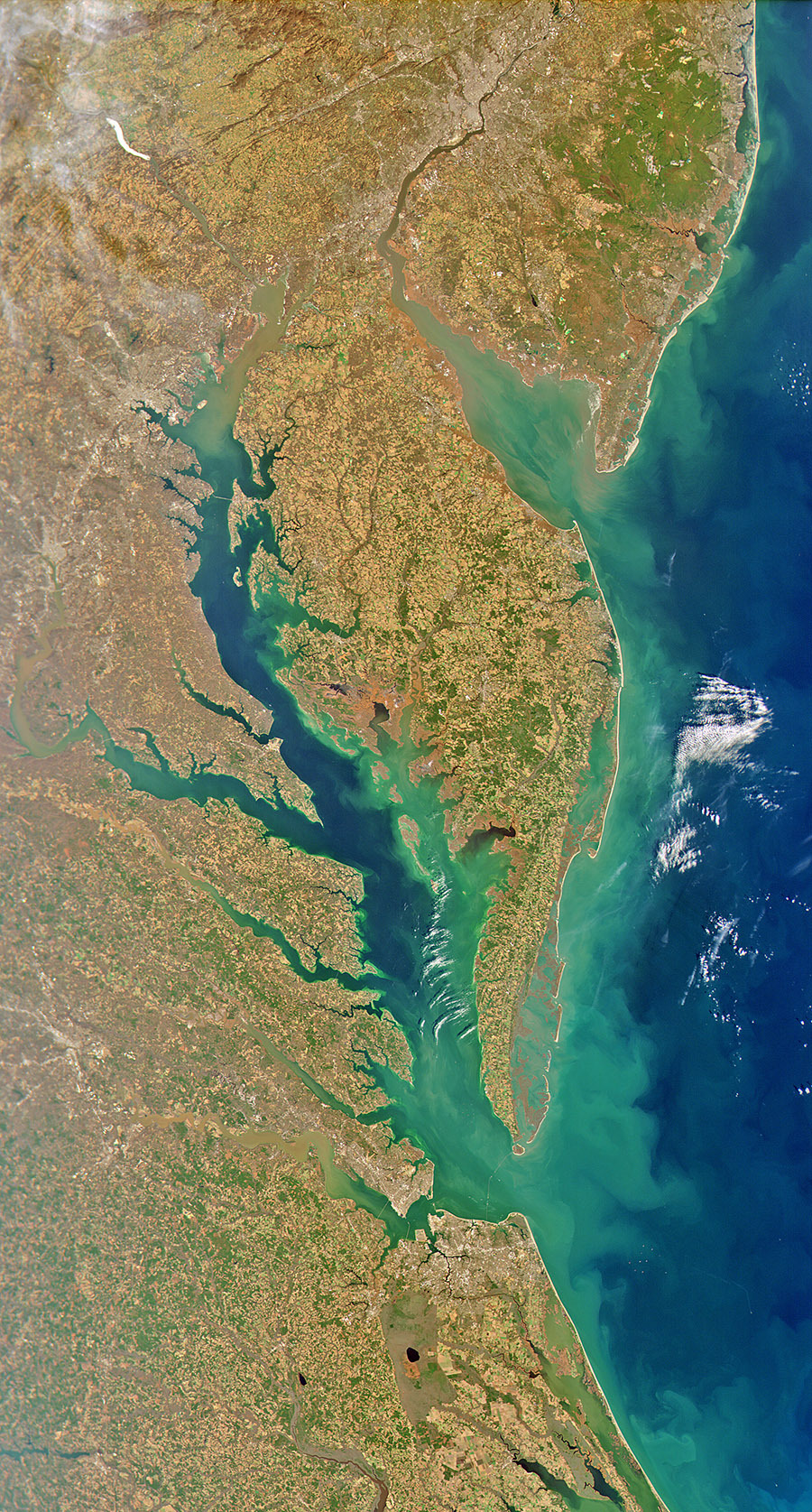
4. Building ocean satellites the size of a shoebox 📦
NASA’s HawkEye instrument collects ocean color data and captures gorgeous images of Earth from its orbit just over 355 miles (575 kilometers) above Earth’s surface. It’s also aboard a tiny satellite measuring just 10cm x 10 cm x 30 cm – about the size of a shoebox!
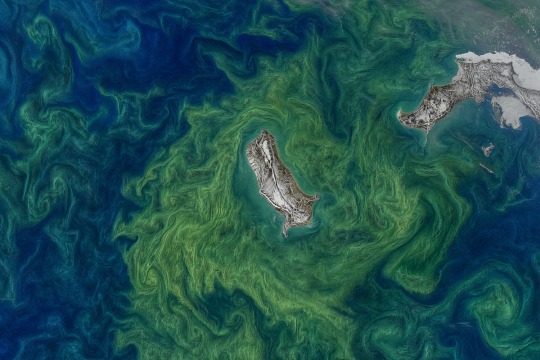
5. Designing new missions to study Earth’s oceans! 🌊
NASA is currently designing a new space-based instrument called GLIMR that will help scientists observe and monitor oceans throughout the Gulf of Mexico, the southeastern U.S. coastline and the Amazon River plume that stretches to the Atlantic Ocean. GLIMR will also provide important information about oil spills, harmful algae blooms, water quality and more to local agencies.

6. Taking the ocean to new heights ⬆️
The U.S.-European Sentinel-6 Michael Freilich satellite is helping researchers measure the height of the ocean - a key component in understanding how Earth’s climate is changing.
This mission, which launched in 2020, has a serious job to do. It’s not only helping meteorologists improve their weather forecasts, but it’s helping researchers understand how climate change is changing Earth’s coastlines in real time.
Make sure to follow us on Tumblr for your regular dose of space!
2K notes
·
View notes
Text
A lot of people don't know about why lawns are so disliked outside of how they are a waste of water, so here:
carbon emissions put out by lawn mowers (and other devices like leaf blowers). Lawn mowers produce significantly more greenhouse gases per hour of use than cars, and majorly contribute to smog.
Fertilizers get into bodies of water and cause algae blooms, converting all the diverse water plants to homogenous green slime.
Pesticides kill fireflies, bees, and all sorts of other beneficial insects, and many can kill or harm fish, birds and even humans.
Herbicides can have negative effects on the wrong targets too, but they are also causing common agricultural weeds to evolve resistance faster, increasing our dependence on pesticides.
Watering lawns does waste a lot of fresh water.
Lawns replace areas that once could have contained 100+ plant species with monocultures of frequently invasive species. Butterflies can't find host plants this way. Bees can't find food. Thousands of insect species rely on specific plants for food, and no other plant will do. A huge amount of the land is taken up by these wastelands.
Lawns also create dead, compacted, lifeless soil that is hard to grow other things in or near. The root systems of turf grasses are not robust enough to allow water to penetrate in. No matter how much nitrogen and phosphorous you dump on a lawn, it will still be lacking in the organic matter needed to create lush, absorbent dirt.
Dirt is supposed to be full of fungal mycelium. Scientists have discovered recently that the vast majority of all plant species are dependent on a network of symbiotic fungi attached to their roots for 80% of their phosphorous needs and 90% of their nitrogen needs.
Yes, this means that when you put a fungicide on your lawn, you've just nerfed that plant's ability to absorb nutrients by up to 90%. And you've also devastated its ability to absorb water, because plants are partly dependent on their fungi to get water out of dirt.
But fungicide isn't the only problem. Every plant in a natural environment is attached to multiple species of fungus, and most fungi are attached to multiple species of plant (though some are specialists). Trees literally use this system to send nutrients to other trees. We discovered recently that trees in deserts in California can survive extreme drought because they're attached to fungi that can break down rocks and extract water from the rocks.
If you don't have a good variety of plant species and rotting leaves and sticks and stuff, it doesn't matter how much fertilizer you put on it, your soil isn't "healthy" because it's not alive.
Vegetation that has been cropped extremely short doesn't hold in water, so a heavily maintained lawn is likely unnaturally dry for your climate, and a flower or bush in the middle of a lawn without tall grasses, shrubs and weeds nearby is getting pounded by the sun much harder than it's meant to handle.
Yeah, gardening isn't hard, most native plants are falling all over themselves to grow, it's just that the standard suburban backyard is ridiculously hostile to life.
Of course at this point you may be wondering
"What do I do instead?"
Well, here you go:
Stop weeding, spraying and fertilizing. Seriously. Stop it!! Stop it!! Chemical intervention in your lawn traps you in a vicious cycle of creating problems that need to be solved with more chemicals.
"Weeds" are a perfect example. Plants commonly considered "weeds" are adapted to take over areas that have been cleared out of other plants. Many "weeds" are actively harmed by the fungi that other plants depend on, meaning they can ONLY thrive in disturbed or devastated areas. The harder you work to eliminate biodiversity in your yard, the harder nature is going to bomb your yard with weeds.
By the way, google the "soil seed bank." Seeds can stay dormant in soil for years or even decades. If you want a "weed-free" lawn, get ready to apply herbicides for the rest of your life.
Mow less often. You really can't go wrong with this one.
Don't try to grow grass where grass doesn't want to grow. Lots of shade? Try moss. Extremely dry? Try drought-adapted plants. See what wants to grow there and let it do its thing.
It's fine to have a lawn area that you actually use. But if no one walks or plays on a stretch of your lawn, it should be something else. A wildflower patch, a stand of prairie grasses, some large shrubs, a grove of trees.
By the way, the idea that shrubs or flower beds are higher maintenance than lawns is wrong. The neat thing about native species is that once they've gotten settled, you literally just do nothing.
People think flower beds are high maintenance because people almost always underpopulate them. They think that there should be big spaces of mulch in between each plant. In a full sun flower bed that's actually filled to capacity, you shouldn't be able to see the ground. If your plants aren't babies anymore and there's still space, more plants.
if you live in an area that was once forest, PLEASE, plant some trees, and not just one tree. Trees are somewhat like guinea pigs, actually, they don't want to be alone. They send each other nutrients through their roots and screen each other from wind damage.
By the way, the "mature spread" of a tree as told on websites means when you plant it by itself. Trees can generally be planted 6-10 feet apart and be perfectly happy, they'll just grow taller and straighter instead of spreading out. (Look at pictures of forests.) HOWEVER large trees like large oaks should really be 25+ feet from structures and septic tanks
(Trees pop up by themselves in lawns. Constantly. Search for them in a woodland biome and you will likely find baby oaks and maples and other cool guys.)
Trees introduce competition for light into the areas you plant them, helping eliminate the "weeds." You know how fast your lawn grows up and gets weedy when you don't mow it? Yeah, that's partly because it's getting a CRAP TON of sunlight dumped on it with reckless abandon.
A shade garden gets "weedy" WAY slower, and unlocks all sorts of gorgeous flowers that don't thrive in a full sun garden. Fallen leaves serve both as compost and mulch. If you live in the right area for it and have room, you cannot go wrong with trees.
6K notes
·
View notes
Text
Un-Actions, or Restriction of Activities
This is my first post in a series I’ll be making on how to increase biodiversity on a budget! I’m not an expert--just an enthusiast--but I hope something you find here helps!
There’s a good handful of ways you can help increase biodiversity in your yard that don’t require buying things--in fact, these may actually help you save money in the long run! They may seem small and simple, but every bit counts! Whether you can do these in totality, or just limit how often you do these actions, it’ll make a difference.
Not Mowing, or Mowing Less Often

Turf grass lawns are considered a monoculture, meaning they don’t provide much opportunity for insects to find habitat--so few other creatures find them enjoyable either. An expanse of turf grass is, in many ways, a barren wasteland in the eyes of wildlife--too exposed to cross, with few to no opportunities for food or shelter, leaving them exposed to blazing hot sun, freezing cold, or any predators that may be lurking nearby. A place to be avoided. The simple act of letting your grass grow unbothered gives a chance for wildflowers to grow, and for your grass to grow taller--providing more habitat for insects, which then provides more habitat to birds and other creatures that feed on said insects. Wildlife want nothing more than to skirt by unnoticed, so even leaving the grass tall along the edges of a fence or yard can help a little. Even restricting mowing to every other week, or at a higher blade setting, can be a huge help. If HOAs or city ordinances are fussy about lawn length in the front yard, you can likely still keep grass higher in the backyard. Or, you can create a ‘feature’ where grass is allowed to grow long in a specific area. If it looks purposeful, people are more likely to accept it. Not mowing under trees or close to shrubs not only leaves space for wildflowers to grow, but also means you don’t have to deal with mowing over bumpy roots and other difficulties. Cutting different areas at different times can be an option for letting grass grow long in some areas while still having available places for play and entertainment. I’ve seen some people plant flower bulbs when pulling up weeds, so in the future they'll bloom in early spring before mowing is usually necessary. This could be another fun way of adding biodiversity to a lawn without--or before you--begin mowing in spring.
Not worrying about mowing, or doing it less often, saves you in time, money, and energy. You won’t have to buy as much gasoline for your mower, and Saturday afternoons can be free to be enjoyed in other ways aside from being sticky and sweaty and covered in grass stains. In addition, you’ll likely be lowering your own carbon emissions!
If you do have to mow your lawn, I’ve got ways you can use your grass clippings to boost biodiversity later in the post series!
Not using pesticides, herbicides, fungicides, etc.
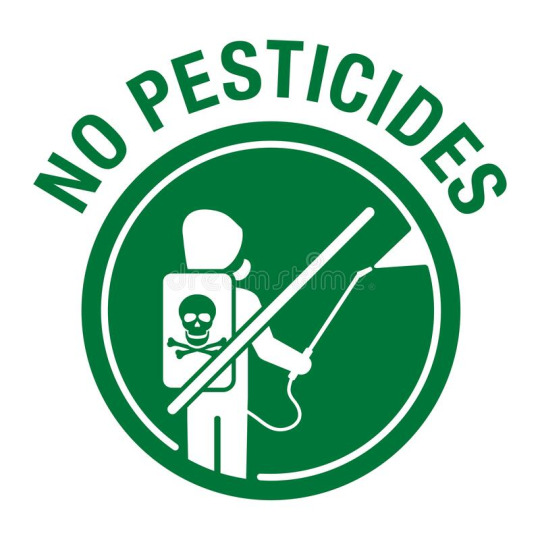
One of the next-biggest non-actions you can do asides from not mowing is using fewer fewer to no herbicides, fungicides, and pesticides in your yard. This’ll easily allow for more biodiversity. Allowing more insects and a wide array of plants to thrive will feed back into the entire food chain in your area. In addition, these types of chemicals have been tied to algae blooms, death of beneficial insects, harm to birds, fish, and even humans. Soil is supposed to be full of fungi, especially fungal mycelium that essentially acts as a network for plants to communicate, share nutrients, and support each other--fungicide kills that, and typically makes all other lawn problems even worse in a negative feedback loop. It may take awhile to see the benefits of avoiding these chemicals, but once you see it, it really is astounding.
However! I can’t lie and say that there haven’t been points where I needed to use pesticides at some points in my gardening journey. In these cases, try to use products that are organic--like diatomaceous earth, neem oil, etc--and use them accurately, correctly, and sparingly. Follow instructions on how to apply them safely and responsibly--for example, on non-windy days and during times when bees and other pollinators aren’t likely to be out and about. With some pests (read: oleander aphids, in my experience), a simple jetstream of water is enough to force them off the plant where they’ll be too weak to get back. Eventually, you should have a balanced enough ecosystem that no one insect pest causes a major issue with the work you’re doing to boost biodiversity.
If you can bear to, try handling pests manually. Squishing pest bugs in your hand is a pretty foolproof way to get rid of some problems, or spraying them with a mix of soap and water can do the trick on some insects. Alternatively, picking them off your plants and into a bucket of soapy water is also a valid option. You’ve heard of baptism by fire, now get ready for… baptism by soap?
But also! Try reconsidering what you consider a pest! Tomato hornworms are hated by gardeners, for devouring the foliage of beloved tomato, pepper, and potato plants. But killing the tomato and tobacco hornworm means getting rid of sphinx moths, also known as hummingbird or hawk moths! Hawk moths are vital to the survival of many native plants, and are sometimes even the only species that pollinates them. If you can bear to, consider sacrificing a few tomato plants, or growing a few extras, so we can continue having these beautiful moths for years to come. After all, they may not even do significant damage to the plants!

With that in mind, be friendly to your natural pest managers! Lacewings, ladybugs, praying mantises, wasps, birds, bats, and more will help manage pest populations in your environment! Encourage them by planting things they like, providing habitat, and leaving them be to do their work! Avoiding pesticides helps make your garden a livable environment for them, too!
Letting Weeds Grow
Many of the plants we know as 'weeds' are actually secondary succession species and native wildflowers. Milkweed was regarded as a noxious, annoying weed for a long time, and now people are actively trying to plant them after learning about the important role they play in our environments! Weeds are adapted to take over areas that have been cleared out of other plants after a disaster, so they're doing much of the initial work in making a habitat for other creatures. In fact, many of them will simply die back as the environment repairs itself.
An important thing to note is to please make sure that your ‘weeds’ are not invasive species. Work on learning how to identify native and invasive species in your area, and pull out what’s harmful to leave room for what’s good!
Don’t Rake (Or At Least Don’t Bag Your Leaves)

Many insects overwinter in piles of leaves that we often rake away and bag up in the fall and winter. By doing this, we are actively throwing away the biodiversity of our neighborhoods! If you can, leave the leaves where they fall!
If you do need to rake, put the leaves in places wildlife can still access it instead of bagging it up. Move your leaves into garden beds to serve as mulch, or along the edge of fences to rest while keeping egg cases and hiding bugs intact and free to release come spring.
Leave Snags Where They Are
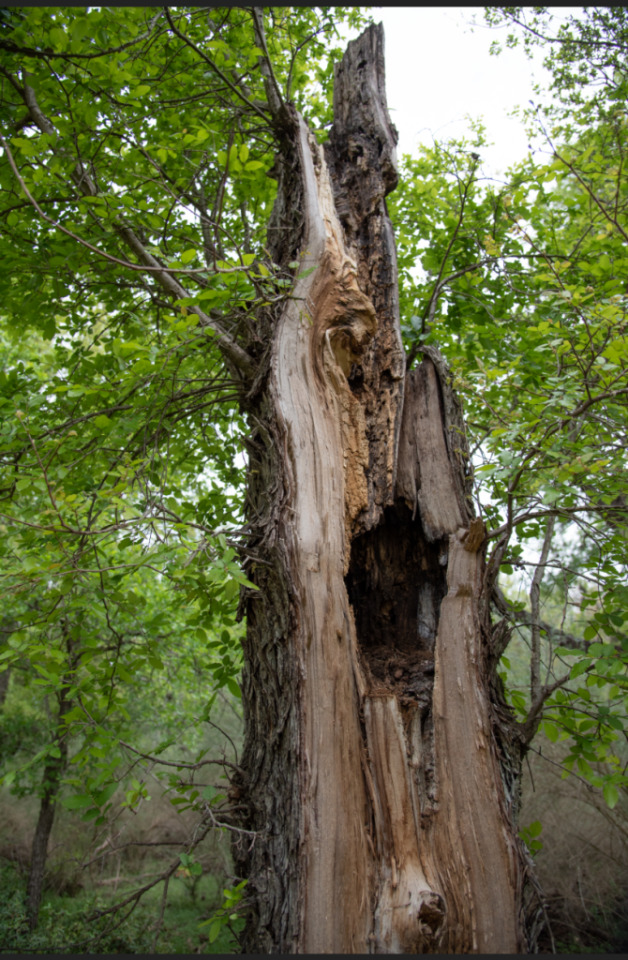
Snags are dead trees/dead branches on living trees. They provide an important wildlife habitat--many birds nest in them, or use them to seek cover from rain, and many insects will also live in snags (making them an additional food source for birds and other creatures). Tree cavities are used as nests by hundreds of bird species in the US, and many mammals use them as well, such as bats, squirrels, raccoons, and sometimes even bears. Some trees form cavities while they’re still alive, but in conifers they’re more likely to form after death. Crevices between the trunk of a dead tree and its peeling bark provide sun protection for bats and amphibians, and leafless branches make great perching areas for birds of prey to hunt from above. The decaying wood is home to insects and fungi, who then feed birds, mammals, amphibians, and reptiles. Do check on the snags regularly to ensure they don’t serve a threat to any nearby structures, but whenever possible, leave them be!
Keep Your Cat Inside
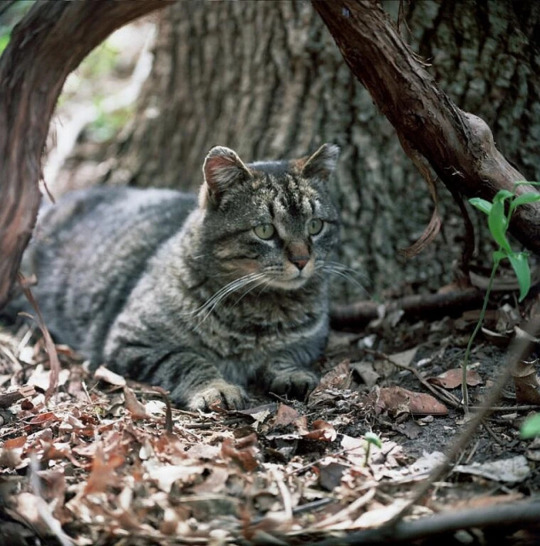
If you have an outdoor cat, consider making the adjustments to have it be an indoor cat. If you have an indoor cat, keep it as an indoor cat. Free ranging cats impact biodiversity through predation, fear effects, competition for resources, disease, and more. Keeping little Mittens inside does a lot more to help than it may seem from the outside.
That’s the end of this post! My next one’s gonna be on things you can add to your space that aren’t directly related to growing plants. For now, I hope this advice helps! Feel free to reply with any questions, success stories, or anything you think I may have forgotten to add in!
#biodiversity#solarpunk#gardening#outdoor gardening#lawn culture#anti lawn culture#environmental stewardship#(i think that counts)#ani rambles#out of queue#the biodiversity saga#I know I said this in the masterpost already but another reminder some people aren't in a position to do all or some or even any of this#i have so far been unsuccessful in convincing my parents to not mow or rake because we live in an HOA neighborhood#but do what you can/are able to! it'll help!
1K notes
·
View notes
Note
hello i believe you asked to be reminded about petalpressed? that sounds very interesting do explain
Hello yes! okay so rundown of Petalpressed:
In general, Petalpressed is an AU template I created that focuses on flower symbolism. It's like a combo hanahaki and soulmate tattoos au, except only taking the best parts of both. So everybody has a "living" tattoo somewhere on their body of a plant (or plant-adjacent, it's very broad - so fungi, lichens, algae, etc also count). The plant, in some way, represents or symbolizes the individual, usually via flower language, though it's totally a personalized thing so you can get as funky with it as you want. It can be absolutely anywhere on their body (face/head, back, legs, etc), take up a completely random amount of space (tip of finger vs entire torso, etc), and it will change based on the state of the individual.
Okay rest including PJO-ification under the cut cause this got long:
For example, when the person is a baby their tattoo will appear as just a seed or bulb or whatever is applicable for that plant. The plant will also probably be semi-ambiguous at that point or change plant types as babies don't really have a ton of defining traits. By the time they start settling into being an individual they'll get a more clear plant and it will most likely stay that for the rest of their lives, unless they experience a major shift in their identity that would cause it to change. It also is unlikely to change locations on the body unless for the same reason. The plant will also reflect the person's physical or emotional state, such as wilting if they're very sick or upset, blooming if they're extremely happy, etc etc. Some people may also have generalized versus specific tattoos, such as general "roses" rather than "roses of a specific color" in which case their tattoo may change colors to match mood/plant language associated with that specific color of the plant/or just at random, depending on person.
The soulmate/hanahaki thing comes in when the person develops romantic feelings or enters a mutual romantic relationship (specific because i'm aroace so I like including normalization of not having a partner, even QPP - there's still leeway there though with how individuals categorize "romantic" and obviously it's a template so there's freedom to mess with it). If they have a crush they may start coughing up the plant or parts of the plant associated with that person, though it doesn't cause them any physical harm. Does the coughing-up-petals thing go away once the relationship is reciprocated or is it just a thing that Happens When You're In Love Sometimes At Random? Who knows. You decide. If they enter a mutual romantic relationship with someone, their partner's (or partners') plants or a part of their plants will appear beside their own, and will change depending on the state of the relationship or partner's physicality or emotions. If their relationship is going well, the plant may bloom, if it's going poorly it may wilt, etc, and same if the partner(s) are upset/sick/etc. If the relationship breaks off or is no longer reciprocated the secondary plant will disappear, and if it left a particularly strong impact on the individual, residual parts of the partner/partners' plant(s) may be left behind, such as leaves, seeds, or petals. It depends on the person/relationship if those remnants will ever go away or how long it may take.
"Plant compatibility" is totally a horoscope-type thing in this universe alongside stereotypes of types of plants, and that's where the "soulmate" concept comes in. It is up to discretion if it is actual soulmates or just coincidental, but in-universe there is an idea of "If you share an exact plant with somebody, you are soulmates." Again, re: horoscope thing, here it could totally just be a coincidental thing based on "If you share a plant that is meant to symbolize you, chances are you have similar personalities and so will get along." There may be people with the total opposite perspective - "Don't date someone with the same plant" because maybe having similar personalities means you'll totally clash. Those concepts probably co-exist in practicality. Lots of variety. Also totally up to customization if the plants have to be local to where the person's from or be from anywhere or how much you want to stretch the definition of "plant" or etc etc. Lots of fiddling options.
I do have a sideblog for it as a more generalized template - @petal-pressed. Since it's a template, it's meant to be applicable to any fandom and totally free to use, and I occasionally post prompts on that blog. And again, the template intentionally lots of room for fiddling and freedom.
Anyways the PJOification of all of this:
"What ships are this au" Whatever's funniest/most dramatic in the moment. Go wild. Make your own variations or whatever.
Everybody's plants: (subject to change)
Percy & Annabeth - Bluebells (They match) - Annabeth's on arm where she got stabbed, Percy on small of back.
Grover - False goat's beard, placement undecided
Piper - Anemone (plant not animal), placement undecided
Jason - Forget-me-nots, right forearm
Leo - Hydrangea, placement undecided
Hazel - Clover, possibly forearm
Frank - Undecided but Snapdragons maybe, possibly forearm
Reyna - Jonquil, possibly forearm
Nico - Dandelions, wrist
Will - Sunflowers, side of torso/back
Luke - Originally Lilacs on face, changes to Rhododendron and spreads to shoulder/armpit.
Thalia - Eastern White Pine, placement undecided
Calypso - Undecided but Hibiscus or Zinnia maybe, placement undecided
I have some other notes for other characters but theyre all very noncommittal
I made a lot of random moodboards for this au but since they were just for personal use I don't have the credits for the images and so will not post those. If people are interested I might take requests to make new ones though. They're quite fun for me to make.
And random doodles - The first one is an extremely old one that was just me fiddling with random designs + cameo Solangelo to show off how the plant tattoos might look

And then some more recent ones:
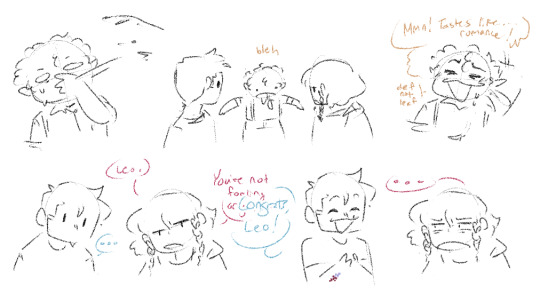
I usually do aro/ace Leo for these aus, so here's him pretending to cough up plants as if he had a crush ^

and some silly Jasico ^
Some other misc fun notes I had for random things:
"Is this canon-verse au or non-canon-verse?" you may be asking. The answer is. Depends. You decide. Again this is not a fully fledged singular au it's just me rotating a template in my brain and it happened to be formed around PJO initially.
Because Percy and Annabeth both have bluebells as their flower, when Percy disappears and loses his memory, both he and Annabeth can't tell if they have only their own flowers or the flowers of two people and it totally freaks them out.
Also because they share flowers, when Nico has his crush on Percy and is thus coughing up bluebells, people presume he has a crush on Annabeth because those are her flowers too. He's not having a great time.
One variant of the thoughts my friends and I brainstormed for Jason was that he and Reyna were dating before he disappeared, and when he lost his memory it also made Reyna's flowers disappear from his tattoo completely. It took longer for Jason's flowers to fade from Reyna's tattoo and she just got to watch Jason's flowers change depending on his state wherever he was until they disappeared too.
Nymphs are obviously pretty one-for-one with their plant. If they even have tattoos is up to you. Either way this does mean Lavinia is coughing up poison oak though so she's having a bit of a rough time. She thinks it's totally worth it though. The coughed-up plants don't really hurt you as bad as the actual plant might, if at all, so she's fine in general.
I had other thoughts too but i'm forgetting.
uhh anyways yeah i think that's about it. woo flower au.
#pjo#riordanverse#ask#spaceyaceylesbian#petalpressed#au#my art#ask to tag#yippee. this au is very fun to me#just cause you can mess around with a lot of stuff#i do have other doodles/designs of this au if anyone is curious to see those#but they're general random designs not pjo-specific#again this is basically me looking at both hanahaki and soulmate tattoo aus and going ''im going to take the fun parts of both of these''#''and just ditch the rest''#still plenty of angst potential if that's your jam but also way easier to keep it fluffy#also i only half-proofread this so if clarification or further detail is wanted on anything feel free to ask#i am always happy to talk petalpressed i think it's neat
41 notes
·
View notes
Text
‘The major cause of pollution in the U.K. is no longer industry, and no longer sewage pitfalls, harmful and poorly regulated as these are. It’s farming. Overwhelmingly, the worst farm pollution is caused by livestock, particularly dairy cows. Where milk production is concentrated, our rivers are dying. In Wales, for example, the collapse of sea trout populations maps neatly onto the distribution of dairy farms.
There are similar situations throughout the rich world. Farm waste - especially from livestock farms - has in many wealthy countries become the biggest cause of water pollution. This holds true even in Ireland and New Zealand, which have invested heavily in marketing what they call their ‘pure’ food. Dairy farming in New Zealand devastates river life, threatens native fish with extinction, contaminates groundwater and closed beaches by feeding blooms of toxic algae in the sea.
Even in China, blighted by industrial pollution, pig manure now seems to be main cause of lake and river death. The Global Standard Livestock Farm created the Global Standard River: over-fertilised and hostile to all but a handful of species.’
George Monbiot, Regenesis: Feeding the World Without Devouring the Planet
273 notes
·
View notes
Text




Evette and I went to my favorite local beach again yesterday! 🏖️ This time she wore Gran E’s vintage sunflower swimsuit 🩱🌻 from her story (or as close an approximation as I could find on Etsy). We waded in the shallows 🌊 for a bit, then Evie pulled her hat down over her eyes and sunbathed ☀️ while I went swimming (I kept a close eye on her, of course).
.....
“Wow, the lake here is really beautiful!” Evie said, looking out over the expanse of blue water. Then she saw Marley’s frown. “What?”
Marley sighed. “Today it’s beautiful, and this beach especially is usually nice, but we actually have a lot of problems with the lakes here, especially after a heavy rain. Madison was built on marshland, so when it rains a lot, we have a high risk of flooding, and all that water sweeps things from the city into the lakes, like pesticides and fertilizer. Then, if it gets hot right after a rain, we’ll get blue-green algae blooms from the fertilizer that got washed into the lake combined with the heat.” Marley saw Evette looking worried. “It’s totally fine today, I checked the water quality online before we left. Plus, it’s obvious when the water is bad: it gets cloudy and green, and you can smell it. I just wish our city government cared more about cleaning up our lakes.”
“Why don’t you do something yourself, like how my friends and I organized a cleanup of the Anacostia River?”
“Well, it’s more difficult than just trash in the water. The big problem is the pesticides and chemicals and stuff, so the best solution would be making stricter regulations on that sort of thing and enforcing them.”
“Well…” Evette said thoughtfully. “Maybe just talking about it, like you’re doing with me, can help at least a little. Raising awareness of the reasons this happens could make individuals less likely to use harmful pesticides on their gardens, and also put pressure on your local politicians to prioritize environmental regulations.”
Marley nodded. “I like that idea.” They paused, then grinned. “For now, since it’s nice, let’s get in the water!”
#american girl#american girl doll#doll photography#evette peeters#world by us#beach#lake#madison wi#environmentalism
26 notes
·
View notes
Text
By Julia Conley
Common Dreams
Aug. 4, 2023
The global average ocean surface temperature is expected to rise even further in the coming months as El Niño strengthens.
Climate scientists on Friday said the rapidly rising temperature of the planet's oceans is cause for major concern, particularly as policymakers in the top fossil fuel emissions-producing countries show no sign of ending planet-heating oil and gas extraction.
The European Union's climate agency, Copernicus Climate Change Service, reported this week that the average daily global ocean surface temperature across the planet reached 20.96°C (69.7°F), breaking the record of 20.95°C that was previously set in 2016.
The record set in 2016 was reported during an El Niño event, a naturally occurring phenomenon which causes warm water to rise to the surface off the western coast of South America. The weather pattern was at its strongest when the high ocean temperature was recorded that year.
El Niño is forming this year as well, but has not yet reached its strongest point—suggesting new records for ocean heat will be set in the coming months and potentially wreak havoc in the world's marine ecosystems.
Samantha Burgess, deputy director of Copernicus, told the BBC that March is typically when the oceans are at their hottest.
"The fact that we've seen the record now makes me nervous about how much warmer the ocean may get between now and next March," she told the outlet.
The warming oceans are part of a feedback loop that's developed as fossil fuel emissions have increasingly trapped heat in the atmosphere.
Rising levels of carbon dioxide in the atmosphere are warming the oceans, leaving them less able to absorb the emissions and contributing to intensifying weather patterns.
"Warmer sea surface temperatures lead to a warmer atmosphere and more evaporation, and both of these lead to more moisture in the atmosphere which can also lead to more intense rainfall events," Burgess told "Today" on BBC Radio 4. "And warmer sea surface temperatures may also lead to more energy being available for hurricanes."
The warming ocean could have cascading effects on the world's ecosystems and economies, reducing fish stocks as marine species migrate to find cooler waters.
"We are seeing changes already in terms of species distributions, prevalence of harmful algae blooms popping up maybe where we would not necessarily expect them, and the species shifting from warmer southern locations up into the colder regions as well which is quite worrying," Helen Findlay, a biological oceanographer at the Plymouth Marine Laboratory in the United Kingdom, toldThe Evening Standard.
"We are also seeing more species coming up from the south, things like European anchovy or recently examples of Mediterranean octopus coming up into our waters and that is having a knock-on impact for the fish that we catch, and consequences of economics," she added.
Certain parts of the world's oceans provoked particular alarm among scientists in recent days, with water off the coast of Florida hitting 38.44°C—over 101°F—last week.
The National Oceanic and Atmospheric Administration told the BBC that ocean temperatures in that area typically hover between 23°C and 31°C at this time of year.
Since scientists first began measuring ocean temperatures using satellites and research buoys about four decades ago, the global average sea surface temperature has gone up by roughly 0.6°C.
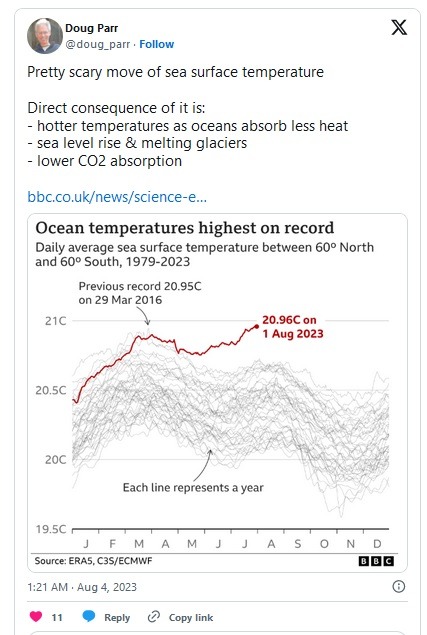
On social media, climate scientists urged news outlets to explicitly connect the rising ocean temperatures to fossil fuel companies and the policymakers who are enabling them to continue fueling the climate emergency—such as British Prime Minister Rishi Sunak, who announced more than 100 new oil and gas licenses in the North Sea this week.
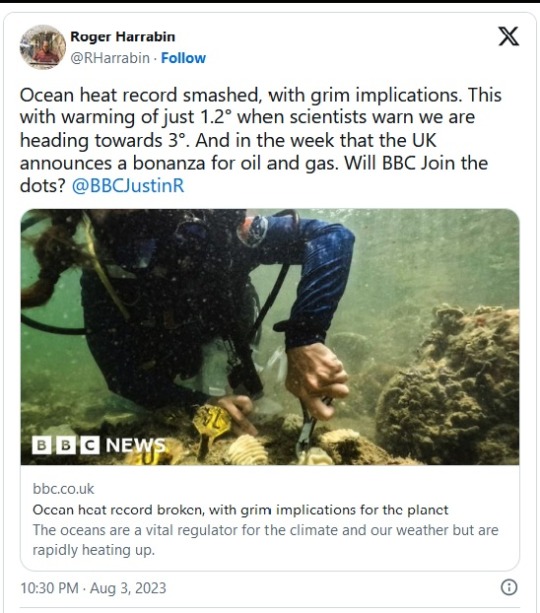
The New York Times this week reported "terrifying Earth breakdown but barely [mentioned] the cause is the fossil fuel industry," said National Aeronautics and Space Administration climate scientist Peter Kalmus.
"The more we burn fossil fuels, the more excess heat will be taken out by the oceans, which means the longer it will take to stabilize them and get them back to where they were," Burgess told the BBC.
Our work is licensed under Creative Commons (CC BY-NC-ND 3.0). Feel free to republish and share widely.
30 notes
·
View notes
Photo


Harmful Algal Blooms or “Red Tides”
A harmful algal bloom (HAB) (or excessive algae growth) is an algal bloom that causes negative impacts to other organisms by production of natural algae-produced toxins, mechanical damage to other organisms, or by other means. HABs are sometimes defined as only those algal blooms that produce toxins, and sometimes as any algal bloom that can result in severely lower oxygen levels in natural waters, killing organisms in marine or fresh waters. Blooms can last from a few days to many months. After the bloom dies, the microbes that decompose the dead algae use up more of the oxygen, generating a "dead zone" which can cause fish die-offs. When these zones cover a large area for an extended period of time, neither fish nor plants are able to survive. Harmful algal blooms in marine environments are often called "red tides".
67 notes
·
View notes
Text
Monster Stars
TAZ Sapphic week day 5 - another chunk of Sword Mermaids (because it wouldn't leave me alone once I wrote the first bit). First meetings. Read below or on Ao3
---
Istus has lived in the lake for long years, ‘as long as she can remember’ years, ‘probably a bit before that even’ years. In that time she’s known humans, mostly the ones she’s handed the sword to, but it’s rare they stick around after the fate of the world has been placed upon their shoulders. Even more rare that they check back in. It’s not that she does it for thanks, she does it because she’s always done it, because the sword always comes back, because the person who needs it always appears at the shore one way or another… but a quick thank you wouldn't go amiss. It's nice to be appreciated.
She’s bathing in moon glow tonight, endless pinpricks of starlight spread across the inky blackness above her, the sword’s safe in the depths. It reappeared a week ago, but there's no sign in the kelp that the new king is on their way, so it’s just her and the fathomless night. It’s magic here, weeds twisting way down below while she hangs in the lake sky. She closes her eyes and relaxes into it, lets the water hold her, lets the waves nudge her gently to and fro. She dozes, kept on the edge of full sleep by the occasional splashes of wildlife.
“It’s beautiful isn’t it?” Says a voice beside her.
Oh no.
There shouldn’t be a voice because there shouldn’t be a person. Maybe she can swim away before they notice?
“I like your tail.” Says the voice. “I think I’ve seen them advertised, is it silicone?”
Oh no.
This wasn’t supposed to happen. She wasn’t supposed to be seen. Well, probably. No one had actually said that, but it was usually part and parcel of these things, wasn't it? She popped up, a head and shoulders at a rocky outcrop, handed over the sword, some highly-likely-to-be-ignored advice, and disappeared mysteriously into the lake. No one saw the fins apart from the fish.
“Hello.” Istus opens her eyes, it wouldn’t do to be impolite… not to mention it’s been a while since anyone asked her a question other than “I’ll be great, right?” or something equally self-absorbed. The lack of screaming was also helpful, she had always thought there’d be screaming.
The visitor had a large shiny eye which reflected the soft light back at Istus, and what looked like a single antenna. They flipped on their back and drifted closer. Istus was delighted to see a pair of disproportionately large webbed feet. She always assumed it was just her left, but maybe there were other mer still!
“You’ve got great taste, the view’s beautiful.” Istus fought down disappointment as the person tugged the shiny eye away and revealed a very human face. “I’m Raven by the way, always nice to meet a fellow night swimmer.”
A knight? If Raven was one they were the nicest knight Istus had ever met, but even so, that meant she must be cautious. They usually either sulked all surly and mysterious in the background while she handed the sword over; or, much worse, decided that she was some kind of threat and postured about killing her if she tried to harm them or the person they protected. Knights certainly didn’t ask questions or admire the view.
“Well met, Raven. I’m Istus. What brought you out here tonight?” There that’s a neutral question, hopefully Raven will be honest about their motive.
“I’m here for the algae.” Raven’s arm bumps Istus’, she doesn’t move it away. “I thought it’d be fun to swim in the glow. Turns out I was right about the fun, wrong about the type of glow!”
“Oh, the algae is beautiful, but it’ll be another few months before it’s blooming.”
“Huh. I’m starting to realise the shop owner may just have been lying to me in order to sell the snorkelling kit. The joke’s on him because I’m going to get a tonne of use out of this - I go so much faster with the fins, look!” Raven flips over and swims in a quick circle.
Istus isn’t entirely sure whether to be baffled or charmed by this so sticks with both at once. “Fins?” She asks, once she finally finishes giggling.
Raven pauses, pops her head up, confusion written across her glistening face. “You know, like flippers?”
Istus realises a moment too late that she’s failing some kind of test.
“Where did you get your tail? Didn’t they have these too?” Raven returns to her back, waggles her long feet in the air.
Istus pauses a second too long.
“Does your tail come off?” Raven’s tone is gentle, curious.
Raven doesn’t seem bad, Istus can usually tell when they’re bad. Plus, Istus isn’t fated to die today, she knows that. She wasn’t fated to meet this person either, but that was probably just a blip.
“It’s okay if it doesn’t.” Raven’s voice is soft, reassuring, there’s not an inch of malice.
“I didn’t buy it.” It isn’t a lie. It isn’t the whole truth, but she doesn’t want to outright lie to Raven, they haven't given her any reason to. Not to mention, it’s been a long time since anyone has come here. She couldn’t remember the last time someone who wasn’t aware of the lady in the lake did.
“That’s smart, means you didn’t get scammed by the same guy as me in town.” Raven looks up to smile at her, droplets of water clinging to her face.
Istus wants to lick them off.
“I certainly didn’t.” Istus says, wonders if it’s reasonable for her to feel such ill will towards the nameless vendor… but Raven’s her friend now, even if they don’t realise it, so anyone who wrongs them is Istus’ enemy. “I’ve always had it.” It’s as close to an admission of the truth as she’s going to get.
“Huh.” Says Raven, thoughtfully. “I always wanted to meet a hot mer. You’re making a baby lesbian’s dreams come true, I think that means the universe owes you one.”
“I think the universe and I are even, but it’s a pleasure to be of service.” Istus smiles up at the stars, she’s glad the knight invaded her lake tonight.
----
Read the next installment: Stars Again
11 notes
·
View notes
Note
The first time I saw you post about the Habs I had no idea what you were talking about (no hockey knowledge here) so I looked it up and it said it stands for Harmful Algal Blooms which is when algae grows out of control to the point where it’s toxic to nearby organisms. This was very confusing to me so I’m curious as to why they’re called the Habs when the team’s name is the Montreal Canadiens
It's short for 'Les Habitants' which was a name for the early French settlers of New France in the 1600s.
some people say that's what the H in the centre of their logo stands for

tho i believe that officially it's just supposed to stand for "hockey"
ANYWAY
that's why they are called the habs which is, in my opinion, a way better name than the Canadians so that's why i use it :)
10 notes
·
View notes
Text

Day 6: Bloom
To me, animal mimicry is both a blessing and a curse. On one hand, it's fascinating to see the lengths animals go to survive, influencing each other and evolving side by side. I love to see how this relationship permanently radiates outward and alters the appearance of so many other species that happen to live in the same area. On the other hand, mimicry can make your job very difficult.
I know I'm not the first biologist with these qualms. Throughout history, so many forms of animal surveyor have fallen victim to our biology. Animals hide themselves in plain sight to prevent predators from finding them; and that's exactly what we are in nature's eyes: predators. Countless animals were deemed threatened or endangered when in reality, they were just hard for us to see. Some were even undetectable for centuries. We lived side by side with countless species who would always be better at hiding than we would be at finding them on our own.
It wasn't until 2234 when the Lancet Scope was invented that we were given a glimpse into how abundant diversity truly is on Earth. Ecosystems thought to be near barren were actually teeming with countless species and contained a deeply varied food web of crafty predators, and even more clever prey. That year, the number of species believed to be on Earth tripled and Scoping became a field surveyor's favorite activity.
After a while, you start to pick up on things without the scope. Little idiosyncrasies and things so barely uncanny that most eyes pass right over them. After a while you get a sort of sixth sense for these kinds of things. You start to notice them before your brain recognizes that you notice them. It takes practice and it's a good skill to learn. One day, it might just save your life.
Today, we made it to the edge of the highland plateau and started our trek down the side of its steep cliffs. Some narrow paths have just barely been worn by the few animals that traverse these mountains. Even the quantity of crab-bugs noticeably dropped compared to the jungle highlands. Small cracks and crevices in the cliff face became anchor points for patches of polyp-grass to grow. Small blooms of strange white, almost algae-like matter crept out from the deeper cracks on the cliff face. Every now and then, the path would widen to a thicker outcrop where more noticeable signs of life could be found. Flowery shrubs and even small pseudo-trees were even able to take root there.
We were thinking of setting up camp on one of these outcroppings when Lily informed me that something was pinging the scope. They scanned for thermals, UV, even so far as to check for eye shine but couldn't find anything. Just as we were about to write it off as a false ping, I could feel that sixth sense gnawing at the back of my mind after glancing at one of the bushes. I’ve only come across a handful of these shrubs all day and it was today that I even learned of their existence, but I could just tell something was wrong about this one.
It was a familiar orange with yellow stamen we've seen so few times coming down this mountain. Its fleshy, transparent blue leaves grew outward from the cliff onto which its hardy, gray coenosarc clung on tight. But something about it just felt off. The more I peered in the more wrong it felt. It wasn’t until I looked around at the surrounding foliage that I was able to pinpoint that uncanny feel of the mystery plant. A gentle breeze blew up the side of the cliff. All the plants would move together; all but one.
Picking up a small stone, I tossed it into the bush. My intent wasn’t to do any harm to the mimic, but rather to startle it, and get it to leave the bush so we could get a better look at what it might be. However, as the pebble bounced off the pseudo-plants leaves the whole bush sprung to life. It leapt from the cliff face onto our outcrop below. Its roots unfurled into four long spindly limbs. The head, tucked neatly away against the animal's back, twisted around as four intense blue eyes peered straight towards us.
From what we could see of the animal, it was a frightening visage. It was primarily bright orange with blue adornments that keep it hidden amongst the blue cabbage bushes even when its intent is not trying to hide. Its lightweight spindly legs give it exceptional agility and speed when traversing these cliffs. All 4 of its eyes, as well as its ears and melon, face forward. This animal clearly has no interest in perceiving anything other than its prey, nor does it have a need to. Just below its jaws, its primary forelimbs have become mantis-like raptorial forelimbs. It quickly became abundantly clear that this animal's hunting strategy is to sneak up on anything it deems to be its prey and strike before the unwitting meal knows it's not a bush. It just so happened we were the creatures in range of striking today.
Fortunately, it turns out the Blue Cabbage’s plan falls apart as soon as it is noticed. Just as soon as it leapt from the cliff, it began to scamper away. Aggressive mimicry relies on the element of surprise above all else. Once it realized that it was tracking something that's better at perceiving than it is at hiding, it cut its losses and went to find food elsewhere. If it weren’t for the time I've spent learning these skills and the technology breakthroughs that better these skills further, there was a good chance my story would've ended here today.
[End Transcription]
7 notes
·
View notes
Text
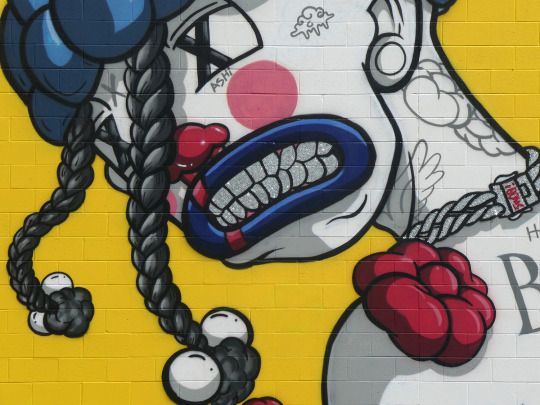
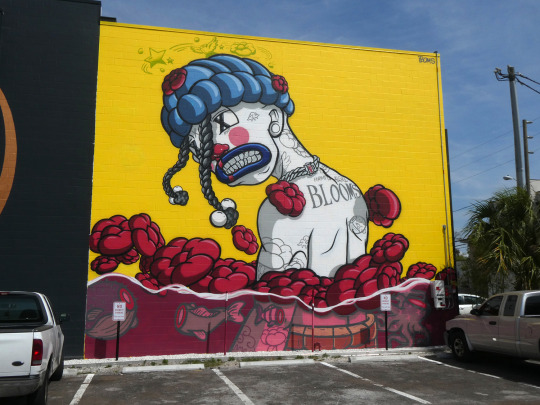
"HARMFUL ALGAE BLOOMS"
by IBOMS
"Did you know harmful algae blooms have tripled since 1984, closing beaches, causing people illnesses, and killing marine life?" In 2020, for year six of St Pete's Shine Mural Festival, @StPeteArtsAlliance partnered with @PangeaSeed Foundation and produced a special Sea Walls: Artists for Oceans edition. For his contribution on the west wall of the Grand Central Brewhouse Jabari Reed-Diop, aka IBOMS, depicted the harmful impact of red tides in a way that also stays true to his artistic style.
LOCATION: 2340 Central Ave, St. Petersburg, FL 33712
IG: @i.b.o.m.s @shineonstpete
6 notes
·
View notes
Text
so, the new desktop fish tank that I’m cycling has turned into an eldritch horror in my absence.
here is the tank about a week after I filled it with water:

here is the tank as of yesterday, which is about 2.5 weeks after I filled it with water (photo courtesy of my pet-sitting friend as I’m currently about 200 miles away):

the weird webbing that you see particularly freaked me out 3 days ago, when it was mostly white in color - because I know to expect brown/green algae in a new fish tank, but never have I seen a white, spiderweb-like substance in one.
that said, this is still super normal for a new, cycling fish tank. the weird alien spiderweb in the image is a combination of a severe bacterial biofilm bloom, and it has taken on a brown-ish color in many places because it also has diatom algae growing on it. ironically, if the ammonia content of the water was safe for living things, shrimp would LOVE to eat this stuff.
the process of “cycling” a fish tank basically involves allowing the development of beneficial bacteria colonies in the tank and filter space so that fish waste that decomposes into toxic ammonia and nitrites is processed into less harmful nitrates (which are in turn removed by plants and water changes). as part of that process, there is an initial bacterial bloom that eventually dies out as the bacteria outcompete each other for food.
now, normally, in my experience, this looks like a white fogginess in the water that goes away after several days to a week. I’ve never had a bacterial bloom actually form biofilms before, and it freaked me out. however, for this tank, I 1) used aquasoil filled with nutrients for the first time, and 2) did a “dry start” for 5 weeks where I planted the tank and kept it covered/misted to let all the plants root prior to flooding it. I feel like these two things probably influenced the creation of the biofilm.
anyway, normal as it is and as unharmed as the plants seem to be, I still hope it dies the heck off before I come home, because it looks super gross.
#personal#aquariums#gross#it looked even worse a few days ago when that stuff was entirely white#I guess because the brown registers in my brain as normal algae#but white threads hit my brain as fungal or bacterial#and lizard hindbrain doesn't like that#petblogging
8 notes
·
View notes